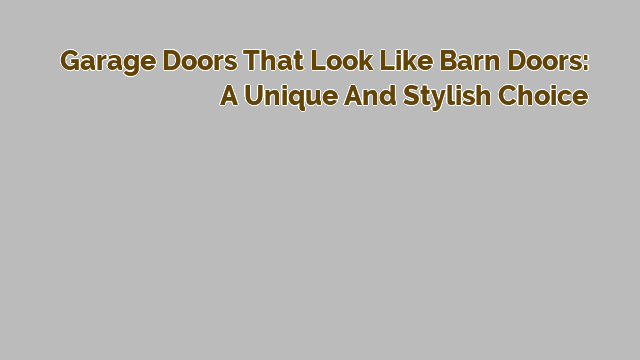Front Entry Gate: A Comprehensive Guide
The front entry gate is the first thing people see when they approach your property. It is an essential aspect of your home’s security, privacy, and aesthetics. Choosing the right front entry gate is crucial for enhancing your property’s appearance and preventing unauthorized access. In this comprehensive guide, we will explain everything you need to know about front entry gates, including their types, materials, designs, installation, and maintenance.
What Is a Front Entry Gate?
A front entry gate is a barrier that restricts access to your property from the street or sidewalk. It can be made of various materials, such as wood, metal, vinyl, or composite. A front entry gate can be manual or automated, depending on your preference and budget. It can enhance your home’s curb appeal and increase its value, while also providing security and privacy.
Types of Front Entry Gates
There are several types of front entry gates, each with its unique features and benefits. Here are the most popular types of front entry gates:
Swing Gates
Swing gates are the most common type of front entry gates. They are hinged on one side and swing open and closed like a door. Swing gates can be single or double, depending on the width of your driveway. They can be made of various materials, such as wood, metal, or vinyl.👍 Pros:- Easy to install and operate- Affordable- Can be customized to fit any style or design👎 Cons:- Require space to swing open and closed- Can be hazardous if not installed correctly- Require regular maintenance
Sliding Gates
Sliding gates are an excellent option if you have limited space in your driveway. They slide open and closed horizontally, parallel to the fence line. Sliding gates can be manual or automated, depending on your preference and budget. They can be made of various materials, such as metal or wood.👍 Pros:- Space-saving- Can be automated for convenience- Secure and durable👎 Cons:- More expensive than swing gates- Require a level driveway for proper installation- Can be challenging to install and maintain
Barrier Arm Gates
Barrier arm gates are commonly used in commercial properties, parking lots, and gated communities. They are a type of swing gate that uses a barrier arm to control access. Barrier arm gates can be manual or automated, depending on the level of security required. They can be made of various materials, such as metal or aluminum.👍 Pros:- Easy to operate- Ideal for high-traffic areas- Can be customized with access control systems👎 Cons:- Limited design options- Not suitable for residential properties- Require regular maintenance
Materials for Front Entry Gates
The material you choose for your front entry gate will affect its appearance, durability, and maintenance requirements. Here are the most popular materials for front entry gates:
Wood
Wood is a classic and timeless material for front entry gates. It is versatile, customizable, and adds warmth and character to any property. Wood gates can be made of various types of wood, such as cedar, redwood, or pine.👍 Pros:- Beautiful and natural appearance- Can be customized with various stains and finishes- Affordable👎 Cons:- Require regular maintenance, such as sealing or painting- Prone to warping, rotting, or insect damage- Not as durable as metal or vinyl
Metal
Metal is a popular material for front entry gates due to its durability, strength, and security. Metal gates can be made of various types of metal, such as steel, aluminum, or wrought iron.👍 Pros:- Strong and secure- Long-lasting and low-maintenance- Can be customized with various designs and finishes👎 Cons:- More expensive than wood or vinyl- Prone to rust and corrosion- Can be heavy and difficult to install
Vinyl
Vinyl is a modern and low-maintenance material for front entry gates. It is durable, lightweight, and comes in various colors and styles. Vinyl gates are made of PVC (polyvinyl chloride) material, which is resistant to weathering, fading, and rotting.👍 Pros:- Low-maintenance- Resistant to weathering and fading- Affordable👎 Cons:- Limited design options- Not as strong or secure as metal or wood- Can crack or warp in extreme temperatures
Designs for Front Entry Gates
The design of your front entry gate can enhance your property’s curb appeal and reflect your personal style. Here are the most popular designs for front entry gates:
Traditional
Traditional front entry gates are characterized by their classic and elegant style. They can be made of wood or metal and feature decorative elements, such as scrolls, finials, or spears. Traditional gates can enhance the charm and character of any property.
Modern
Modern front entry gates are characterized by their sleek and minimalist style. They can be made of metal or vinyl and feature clean lines, geometric shapes, or abstract patterns. Modern gates can enhance the contemporary and sophisticated look of any property.
Rustic
Rustic front entry gates are characterized by their natural and organic style. They can be made of wood or metal and feature elements, such as knots, grains, or rusted finishes. Rustic gates can enhance the cozy and inviting feel of any property.
Installation of Front Entry Gates
The installation of your front entry gate is a crucial step that affects its performance, safety, and longevity. Here are the key factors to consider when installing your front entry gate:
Professional Installation
It is highly recommended to hire a professional gate installer to ensure that your front entry gate is installed correctly and safely. A professional installer can help you choose the right gate type, material, and design for your property, as well as handle the necessary permits and inspections.
Location and Orientation
The location and orientation of your front entry gate can affect its functionality and aesthetics. You should consider factors, such as the width and slope of your driveway, the position of utility lines, and the direction of the sun and wind.
Access Control Systems
If you want to enhance the security and convenience of your front entry gate, you should consider installing an access control system. Access control systems can include features, such as keypads, intercoms, card readers, or remote controls.
Maintenance of Front Entry Gates
Proper maintenance of your front entry gate is essential to ensure its performance, safety, and longevity. Here are the key maintenance tasks for front entry gates:
Cleaning
You should clean your front entry gate regularly to remove dirt, debris, and stains. You can use a mild detergent and a soft brush or cloth to clean your gate, followed by rinsing with water.
Lubrication
You should lubricate the moving parts of your front entry gate regularly to ensure smooth and quiet operation. You can use a silicone-based lubricant or a WD-40 spray to lubricate the hinges, rollers, or tracks.
Inspection
You should inspect your front entry gate regularly to detect any signs of damage or wear. You should check the gate’s alignment, stability, and hardware, such as bolts, screws, or brackets.
People Also Ask
What is the purpose of a front entry gate?
A front entry gate serves several purposes, such as enhancing the curb appeal of your property, providing privacy, and preventing unauthorized access.
How much does a front entry gate cost?
The cost of a front entry gate depends on several factors, such as the type, material, design, and size. The average cost of a front entry gate ranges from $1,500 to $5,000, including installation.
Can I install a front entry gate myself?
It is not recommended to install a front entry gate yourself, as it requires specialized tools, skills, and knowledge. It is better to hire a professional gate installer to ensure proper installation and safety.





